The Philippine Economy took a big hit during martial law. The country’s Economic Growth plummeted. The Philippines became the first in Asia and second globally to get World Bank loans with strict conditions.
These conditions included cutting tariffs and removing import licenses. This change led to a drop in average nominal tariffs from 44.3% in 1975 to 27.6% in 1985. This had a big impact on the Philippine Economy. To grasp the Martial Law effect, we must look at the economic policies and their outcomes on Economic Growth.
Key Takeaways
- The Philippine Economy experienced a decline in Economic Growth during the martial law era.
- Average nominal tariffs fell from 44.3% in 1975 to 27.6% in 1985, affecting the Philippine Economy and Economic Growth.
- Debt increased from US$599 million in 1965 to US$28.3 billion in 1986, contributing to economic inefficiencies.
- Poverty incidence in the Philippines reached 44.2% by the end of the Marcos regime in 1985.
- The country’s debt obligations reached over 57% of GDP by 1986, impacting Economic Growth and the Philippine Economy.
Historical Context of Martial Law Declaration
The declaration of Martial Law in 1972 was a key moment in Philippine history. It marked a big change in the country’s Political Climate. President Marcos led the regime, citing rising disorder and threats from groups like communists and separatists.
The country was also facing tough economic times. Issues like inflation, poverty, and inequality were widespread. This made the Economic Situation very challenging.
Before Martial Law, there were student protests, labor strikes, and clashes between the government and opposition. The regime responded by limiting civil liberties and suppressing opposition. They also tried to stabilize the economy through strict policies.
But these actions had severe consequences. Living standards dropped, human rights were abused, and the country’s debt soared.
Some important statistics show Martial Law’s impact:
- GDP growth averaged 6% per year from 1972 to 1980
- The country experienced a GDP contraction of 7.3% for two consecutive years, 1984 and 1985
- Estimates suggest that per-person incomes in the Philippines could have been 3 to 4 times larger than present if growth had continued in line with ASEAN neighbors
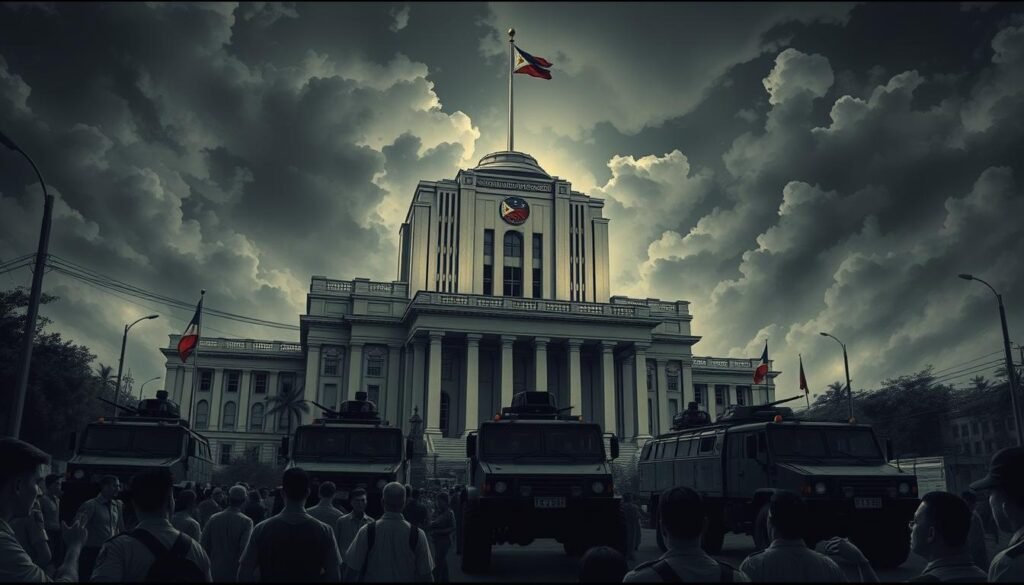
The legacy of Martial Law still affects the Philippines today. There are ongoing debates about the country’s future and the need for sustainable growth. Understanding Martial Law’s history is key to addressing these issues and creating a better future for Filipinos.
The Philippine Economy Under Marcos’s Control
The Philippine Economy saw a big jump in growth during the Marcos regime’s early years. GDP grew by almost 6% each year from 1972 to 1980. This was mainly because of government investments in infrastructure and industrial development.
The Marcos regime put in place many economic policies. One was the Ministry of Human Settlements. It aimed to improve living conditions for low-income families.
The economy during this time was heavily influenced by the government. The Marcos regime’s policies had both good and bad effects on the country. Some key aspects of the economy under Marcos include:
- Increased government spending on infrastructure and industrial development
- Implementation of policies to promote export-oriented industries
- Creation of government agencies to oversee economic development

The Philippine Economy under Marcos showed significant growth and development. But, it also faced issues like inequality and corruption. The regime’s policies have shaped the economy into what it is today.
Key Economic Policies During the Martial Law Era
The Economic Policies during martial law greatly affected the Philippine economy. The Marcos administration brought in Presidential Decrees that changed the business scene. These included rules about Foreign Investment to draw in more investors and grow the economy.
Some important Presidential Decrees made the economy more open and allowed more Foreign Investment. But, these moves hurt local businesses and made the country rely more on foreign money. The Economic Policies led to both growth and decline in the economy.
Key aspects of these economic policies include:
- Liberalization of the economy
- Opening up of key sectors to Foreign Investment
- Implementation of Presidential Decrees to regulate business
- Impact on local industries and the overall economy
The Economic Policies of the martial law era still shape the Philippine economy today. Knowing about these policies and their outcomes is key to understanding the country’s economic journey. It also shows how Foreign Investment has influenced its future.
The Rise of Crony Capitalism
The Philippines has faced challenges with Crony Capitalism, which has slowed Economic Growth. The country ranked fourth globally in crony capitalism. In 2021, the wealth of billionaires was over 10% of the gross domestic product (GDP).
Crony sectors made up nearly 80% of billionaire wealth in the Philippines. This shows a big concentration of wealth and power. It has hurt Economic Growth because cronyism and corruption scare off foreign investors and limit credit access.
Some key statistics about Crony Capitalism in the Philippines are:
- The Philippines ranked fourth globally in crony capitalism.
- Nearly 10% of the GDP in 2021 was in crony-friendly sectors.
- Crony sectors made up 80% of total billionaire wealth in the Philippines.
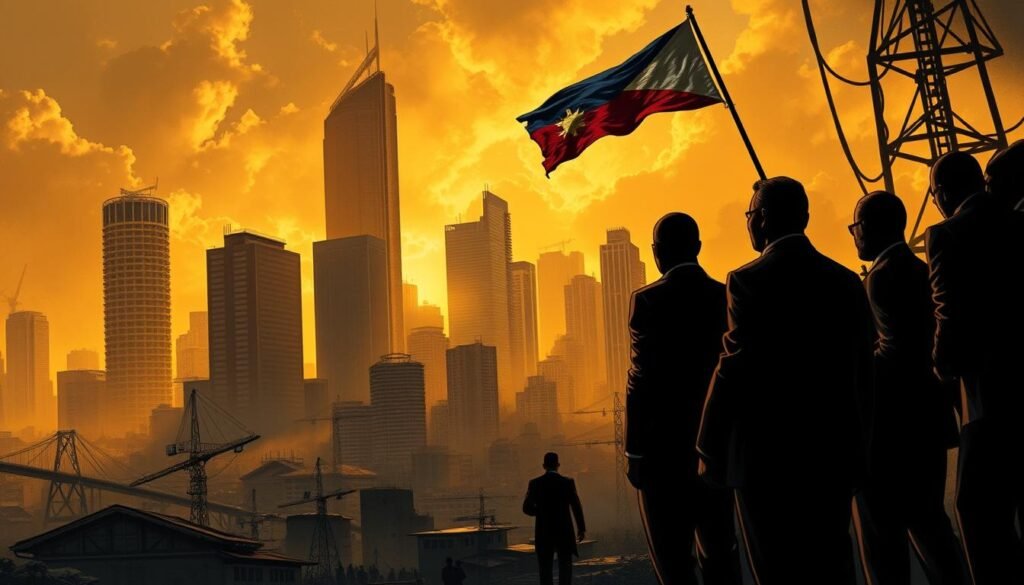
The effect of Crony Capitalism on the Philippine economy is big. Many companies owned by friends of the Marcos family failed and needed state help. This cost taxpayers a lot and scared off foreign investors.
Experts like Dr. Bernardo Villegas say Crony Capitalism has weakened the free enterprise system. It discourages investors and limits credit. To boost Economic Growth, we must tackle Crony Capitalism and ensure fairness for all investors.
Foreign Debt Accumulation and Management
The Philippines’ foreign debt grew a lot during martial law. The World Bank and IMF were key in the country’s economy. By 1988, the debt hit $28 billion, with each person owing about P10,000 (£208.33).
The country had a big debt to pay off. In 1990, daily interest payments were around £3 million. The Bataan Nuclear Power Plant’s debt was especially high, with almost £200,000 daily interest.
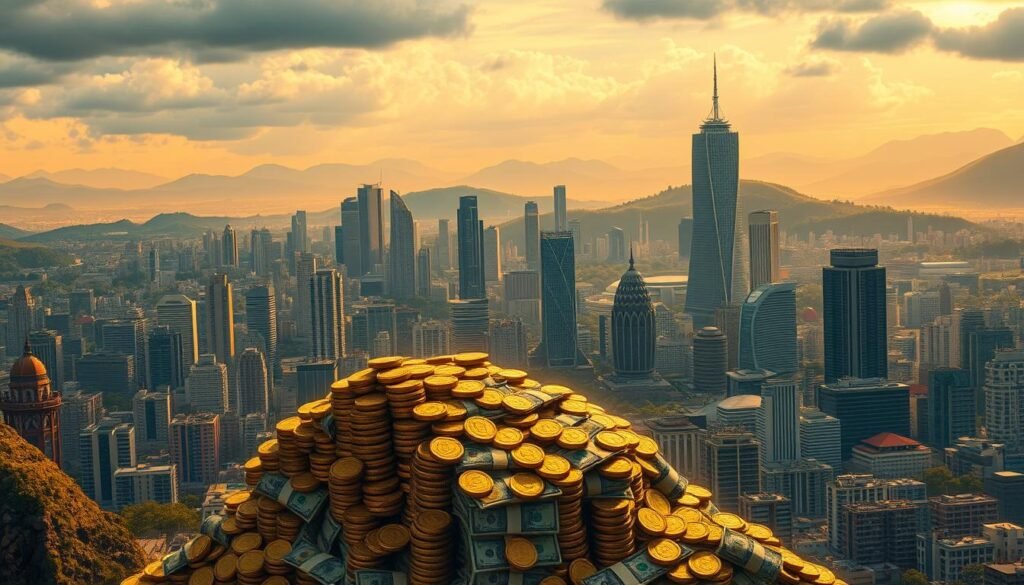
President Aquino’s government spent about 40% of its budget on debt. The IMF and World Bank gave the Philippines $5.5 billion during Marcos’s rule. By 1987, foreign debt was 70% of GDP.
The economy felt the debt’s impact. In 1983, the peso lost 53% of its value. The national debt went from $599 million in 1965 to $24.1 billion by 1983. Today, the Philippines still owes $45 billion.
Agricultural Sector Transformation
The Agricultural Sector in the Philippines saw big changes during martial law. The regime started a land-reform program. This program aimed to give land to small farmers, helping with economic growth and cutting down poverty.
But, the sector still has big challenges. Small farmers find it hard to compete with big agribusinesses. They have more resources and better connections to markets. To help, the government launched the Philippine Rural Development Project (PRDP). It aims to boost rural incomes and farm productivity.
Some important steps to change the Agricultural Sector include:
- Investing in research and development (R&D) to improve crop yields and disease resistance
- Enhancing extension services to provide farmers with technical assistance and training
- Promoting e-commerce and agribusiness start-ups to increase market access and competitiveness

To grow the economy and cut down poverty, the government needs to invest in important areas. This includes infrastructure, innovation systems, and R&D. By doing this, the Agricultural Sector can help drive the country’s growth. It will contribute to food security, jobs, and overall prosperity.
Industrial Development Programs
The Philippine government has launched several programs to boost the economy. A big focus is on the Manufacturing Sector. This sector is seen as key for growth. The government aims to improve existing industries and start new ones, especially in agriculture.
Some main strategies for growth include:
- Improving manufacturing and linking it with agriculture and services. This aims to create strong connections for change.
- Using the Comprehensive National Industrial Strategy (CNIS) to fix supply chain issues and boost global value chain participation.
- Investing in education, small businesses, innovation, and research to lower costs like power and shipping.
The government wants to create better jobs, ensure growth for everyone, and increase trade and investment. The Industrial Development plans aim to make Philippine industries competitive worldwide. The government helps by setting policies and supporting local businesses.
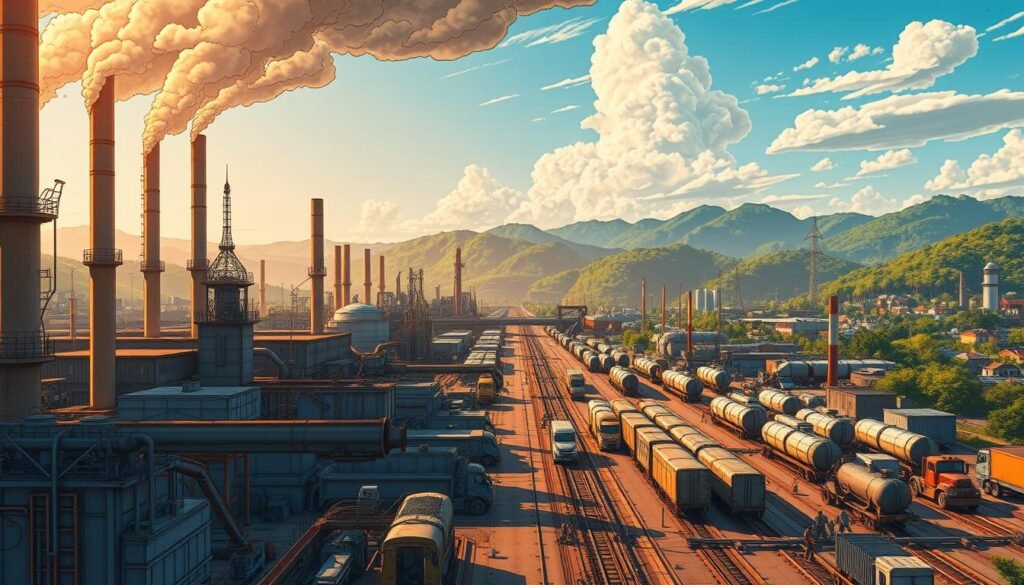
Changing industries will help workers move to better jobs. This will reduce poverty and support lasting growth. By focusing on Industrial Development and the Manufacturing Sector, the government seeks a stronger economy.
Labor Market Changes and Employment
The Philippine Labor Market has seen big changes over time. These changes affect Employment rates. In November 2024, the unemployment rate was 3.2%, close to the target of 4.4% to 4.7%.
There were 49.5 million people working in November 2024. This is 1.4 million more jobs than in October 2024.
The services sector had 62.1% of all jobs in November 2024. Agriculture and industry sectors had 20.0% and 17.9% respectively. The manufacturing sector saw a big jump, with 784,000 more workers than last year.
Other sectors like accommodation, food service, human health, and transportation also grew. For more on labor market trends in the Philippines, visit labor market trends.
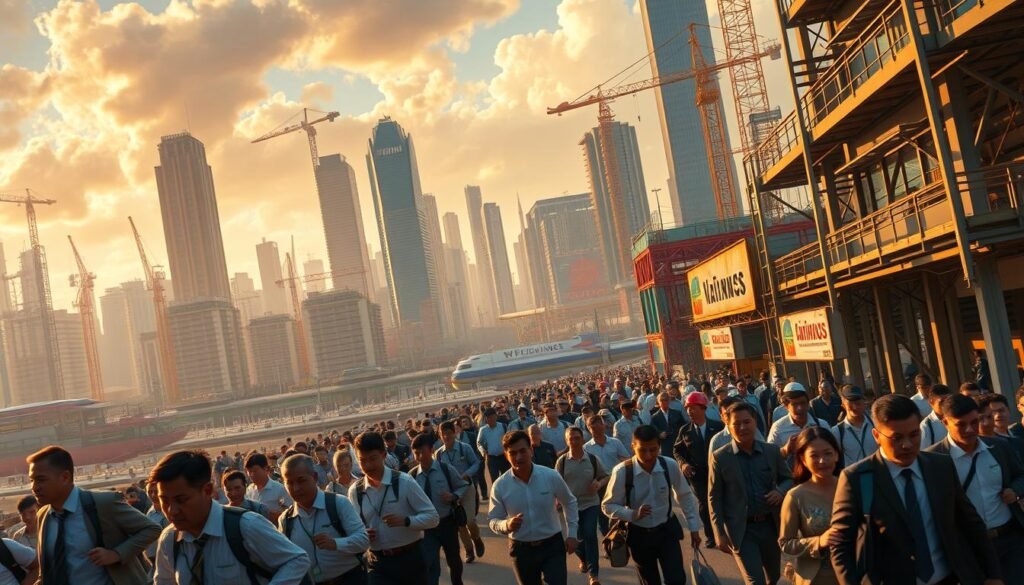
The underemployment rate in November 2024 was 10.8%, down from 12.0% on average from January to November. Wage and salary workers made up 63.8% of all jobs in November 2024, up 1.1 million from November 2023.
Key statistics on the Philippine labor market include:
- Unemployment rate: 3.2% (November 2024)
- Underemployment rate: 10.8% (November 2024)
- Total employment: 49.5 million (November 2024)
- Services sector share: 62.1% (November 2024)
- Agriculture sector share: 20.0% (November 2024)
- Industry sector share: 17.9% (November 2024)
Impact on Income Distribution and Poverty
The Philippine economy has seen big changes in Income Distribution over time. Poverty rates have dropped a lot, from 49.2 percent in 1985 to 16.7 percent in 2018. This is a huge decrease. Yet, the top 1 percent still get 17 percent of the national income, while the bottom 50 percent only get 14 percent.
The COVID-19 pandemic has made Poverty worse, with poverty rates rising to 18.1 percent in 2021. This increase is mainly because of job losses and lower incomes. To tackle this, we need policies that help everyone have a fair chance. The World Bank says cutting inequality is key to a poverty-free middle-class society.

There are big economic and social gaps in the Philippines too. The income Gini coefficient was 42.3 percent in 2018. This shows a high level of income inequality in East Asia. To fix this, we need policies that boost economic growth, create jobs, and include everyone.
State of the Philippine Economy by 1986
The Philippine Economy was in a bad shape by 1986. It had a huge foreign debt and was seen as less trustworthy by others. This was due to low productivity and not enough investment in areas like farming and making goods. The economic growth was slowed down by these issues, making it hard to grow sustainably.
The country faced big problems, like a drop in the growth of the manufacturing sector. It went from 32% in 1983 to 7.9% in 1985. The farming sector, which used to employ at least 50% of people in the 1970s, was also hit hard. The dependency ratio showed a big gap in the economic status of the population, with the poorest 10% having a ratio of 4.2 compared to 2.5 for the richest 10%.
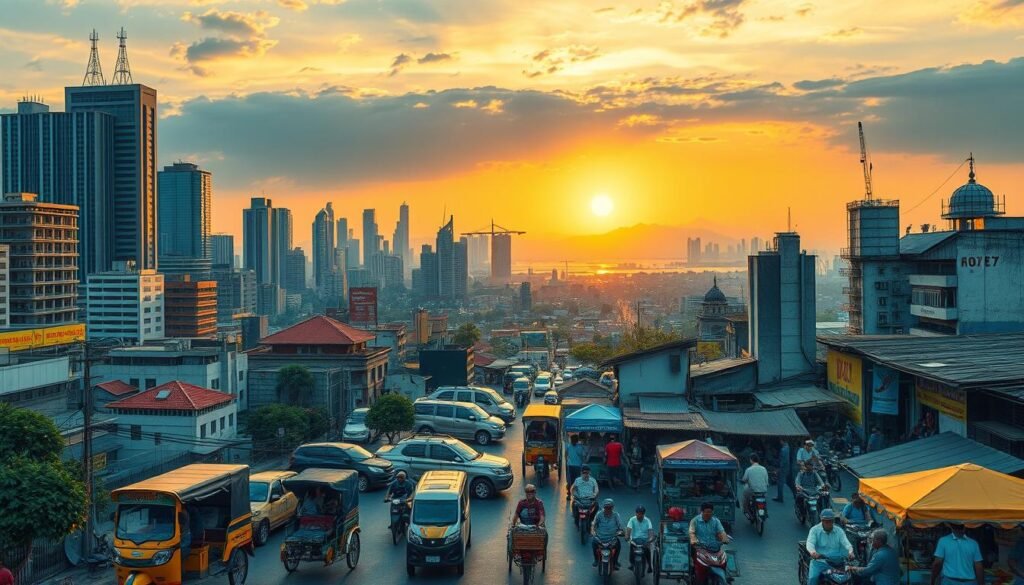
To tackle these issues, it’s key to have policies that boost Economic Growth and development. This means investing in important sectors, boosting productivity, and cutting down the foreign debt. By doing this, the Philippine Economy can bounce back and grow steadily, helping to improve people’s lives.
International Trade Relations During Martial Law
The Philippine economy grew a lot during martial law, thanks to its trade with other countries. The country’s export policies were key in making it competitive in trade. The analysis of the Philippines’ trade strategy shows the Marcos regime’s policies hurt its trade competitiveness.
During martial law, the Philippines’ trade changed a lot. The share of coconut products, sugar, and forest products in exports went down. But, manufactured exports grew fast, with over 30 percent growth each year in the 1970s. The country’s trade partnerships, like with the United States, Japan, and China, also changed.
Some important stats about the Philippines’ trade during martial law are:
* Export growth in the 1970s was 8.6 percent each year.
* Manufactured exports became a bigger part of the country’s total exports.
* The trade deficit with countries like the United States grew too.
The Philippines’ trade during martial law was influenced by many things. These include its export policies, trade partnerships, and global trends. Knowing these helps us understand the country’s economic growth during that time and its effects today.
Economic Recovery Challenges Post-Martial Law
The Philippine economy had a tough time bouncing back after martial law. A big problem was the huge foreign debt, which hit $30 billion by 1983. This debt made it hard for the economy to get back on track.
Reports show the balance-of-payments deficit soared to over $2 billion by 1983. The decline in industrial production and a $1 billion capital flight added to the woes. The government aimed to cut the budget deficit but faced many obstacles.
The following table highlights some key economic indicators during this period:
| Year | Real GDP Growth Rate | Inflation Rate |
|---|---|---|
| 1984 | -7% | 50.3% |
| 1985 | -4% | 23.1% |
The journey to economic recovery after martial law was tough. The country faced huge debts, a drop in creditworthiness, and a big deficit. Yet, the government’s hard work paid off, helping the economy to recover.
Long-term Effects on Modern Philippine Economy
The Philippine economy has changed a lot since martial law. The Philippine Development Plan 2023-2028 aims for a prosperous society by 2040. It focuses on economic stability, health, and teamwork with different sectors.
The Long-term Effects of martial law on the Modern Philippine Economy are clear. The GDP per person fell during the Marcos era and took until 2003 to bounce back. Yet, the economy is set to grow at 6.0% from 2024-2026, thanks to strong demand and household spending.
Several factors will help the Modern Philippine Economy grow:
- Fixed capital investment will boost growth with better business confidence
- Residential building construction is expected to grow by 12 percent
- Local air travel is forecasted to reach pre-COVID-19 levels by mid-2023
Martial law’s effects have left a mark on the economy, like higher foreign debt and a weaker peso. But, the country is set to grow at 6.4% in 2019 and 6.5% in 2020 and 2021. From 2023-2024, growth is expected to average 5.6%.
Conclusion
The Philippine economy has faced big challenges, like Martial Law’s impact. This led to a severe economic crisis and a drop in the country’s credit score. Data from McKinsey shows the economy grew by 5.6 percent in 2023. This growth came from more business activities, spending on public projects, and digital finance.
For 2024, the economy is set to grow between 5 and 6 percent. Inflation is expected to slow down. Sectors like transportation, construction, and finance are seen as key for growth. Understanding Martial Law’s effect on the economy is key to future growth.
The 2023 economic growth forecast was 6.0%, and 2024’s is 6.2%. Inflation was expected to be 6.2% in 2023, but only 4.0% in 2024. These numbers show a positive trend for the economy. The government’s push for more public projects and digital finance will help the economy grow.
FAQ
What was the impact of martial law on the Philippine economy?
Martial law in the Philippines hurt the economy a lot. It led to slower growth, more poverty, and more debt to foreign countries. The few in power got richer, causing big wealth gaps.
What was the historical context of the declaration of martial law in the Philippines?
Before martial law in 1972, the Philippines was unstable and poor. People were protesting a lot, and the economy was bad with high inflation and joblessness.
How did the Philippine economy perform under Marcos’s control?
Marcos’s rule saw some growth but also big challenges. He made many economic rules, but corruption and bad management were big problems.
What were the key economic policies implemented during the martial law era?
Marcos made many rules that affected business and foreign investment. He also changed the banking system, which had both good and bad effects on the economy.
How did crony capitalism rise during the martial law era?
Crony capitalism grew because Marcos favored some people over others. This led to wealth and power in the hands of a few, causing inequality and poverty.
How did the accumulation and management of foreign debt affect the Philippine economy?
Foreign debt was a big problem for the economy. Loans from the World Bank and IMF helped but also led to a weaker peso and higher inflation.
What were the effects of martial law on the agricultural sector?
Martial law changed farming a lot. Marcos’s plans for more farming and better land use helped production but also led to corruption and unfairness among farmers.
How did industrial development programs affect the Philippine economy?
Marcos’s plans for more factories and better roads helped some areas grow. But, corruption and inefficiency hurt other industries.
What were the effects of martial law on the labor market and employment?
Martial law hurt workers a lot. Marcos’s rules on jobs and wages made life harder for many, leading to more poverty and inequality.
How did martial law affect income distribution and poverty in the Philippines?
Martial law made things worse for the poor. Marcos’s policies widened the gap between rich and poor, especially in rural areas.
What was the state of the Philippine economy by 1986?
By 1986, the economy was in crisis. Growth was slow, inflation was high, and poverty was rising. Corruption and bad management were big problems.
How did international trade relations affect the Philippine economy during the martial law era?
Trade policies during martial law had mixed effects. More exports were good but made imports harder, leading to trade deficits.
What were the economic recovery challenges faced by the Philippine economy after the martial law era?
After martial law, the economy had to recover. Slow growth, high inflation, and more poverty needed big changes to fix.
What are the long-term effects of martial law on the modern Philippine economy?
Martial law’s effects still affect the economy today. The country’s economy is still fragile and needs more reforms to grow and develop.
Source Links
- Golden years?: The real long-lasting economic damage wrought by Marcos
- The economic legacy of Marcos – BusinessWorld Online
- Philippines – Martial Law, Marcos, Dictatorship | Britannica
- Martial law in the Philippines
- Was martial law good for the Philippine economy?
- Overview
- Economy of the Philippines
- Economic history of the Philippines (1965–1986)
- The truth about the economy under the Marcos regime
- What Does the Incoming Marcos Administration Mean for the Philippine Economy and International Trade?
- PH ranked fourth globally in ‘crony capitalism’
- The Night I Invented Crony Capitalism
- Crony capitalism
- Philippines – Debt Justice
- PHILIPPINES: Vibrant Agriculture is Key to Faster Recovery and Poverty Reduction
- The Current State, Challenges and Plans for Philippine Agriculture
- Industry Development Program | Department of Trade and Industry Philippines
- Comprehensive National Industrial Strategy – Securing The Future of Philippine Industries
- Recto: PH labor market continues to strengthen at 3.2% unemployment rate in November, second lowest on record since 2005 | Department of Finance
- Philippine Institute for Development Studies
- Employment productivity and wages in the Philippine labor market : an analysis of trends and policies
- KEY FINDINGS Overcoming Poverty and Inequality in the Philippines: Past, Present, and Prospects for the Future
- PHILIPPINES: Reducing Inequality Key to Becoming a Middle-Class Society Free of Poverty
- World Bank Document
- No title found
- Philippines – Market Overview
- Trade Policy, Industrial Policy, and the Exchange Rate
- The economic legacy of Marcos
- The Roots of the Philippines’ Economic Troubles
- NATIONAL WORKSHOP ON
- Philippines Economic Updates
- The Philippines’ economy in 2023 | Philippines
- Philippine Economy to Post Robust Growth in 2023, 2024 Despite Inflation Pressures — ADB
- The Philippine economy under the pandemic: From Asian tiger to sick man again?

